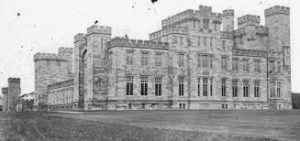 Elizabeth Bowen, the author of The Last September, spent her summers in her family’s country home, Bowens Court. It was built in the 1770s by Henry Cole Bowen and is located in Cork, Ireland. Bowen describes the life in this home (and other big houses) to be “independent” and “secretive” (Bowen 20). Families would be caught up in their own affairs and sometimes would be pent up in the house for days. This physical separateness wasn’t the only isolation though, something internal divided the Anglo-Irish from the rest of Ireland: “an affair of origin” (Bowen 20). Bowens Court had large, lofty rooms, and didn’t belong to any neighborhood, giving Bowen an immense sense of loneliness.
Elizabeth Bowen, the author of The Last September, spent her summers in her family’s country home, Bowens Court. It was built in the 1770s by Henry Cole Bowen and is located in Cork, Ireland. Bowen describes the life in this home (and other big houses) to be “independent” and “secretive” (Bowen 20). Families would be caught up in their own affairs and sometimes would be pent up in the house for days. This physical separateness wasn’t the only isolation though, something internal divided the Anglo-Irish from the rest of Ireland: “an affair of origin” (Bowen 20). Bowens Court had large, lofty rooms, and didn’t belong to any neighborhood, giving Bowen an immense sense of loneliness.
Elizabeth was born in Ireland but moved in with her Anglo-Irish relatives after the passing of her mother. For this very reason, Elizabeth felt torn between the two countries. The main character Lois, in her novel The Last September  shares this liminality.
shares this liminality.
To combat this sense of loneliness and compensate for the feeling of liminality, the Anglo-Irish would build extravagant houses and throw frivolous parties. Around the district where Bowens Court lay, there were three towns: Mallow, Fermoy, and Mitchelstown. The Bowen’s would attend parties at Mitchelstown Castle often. On August 5th, 1914, the family was getting ready to go to a garden party at the castle when Elizabeth’s father had told them England had declared war on Germany. The family went to the castle where the words of the war were unspoken on everyone’s lips. The Anglo-Irish were inadvertently rallying together and renewing the Ascendency. This party would serve as a historic memory and final scene for the castle (in Elizabeth’s eyes) as it would be demolished a short time later. 
